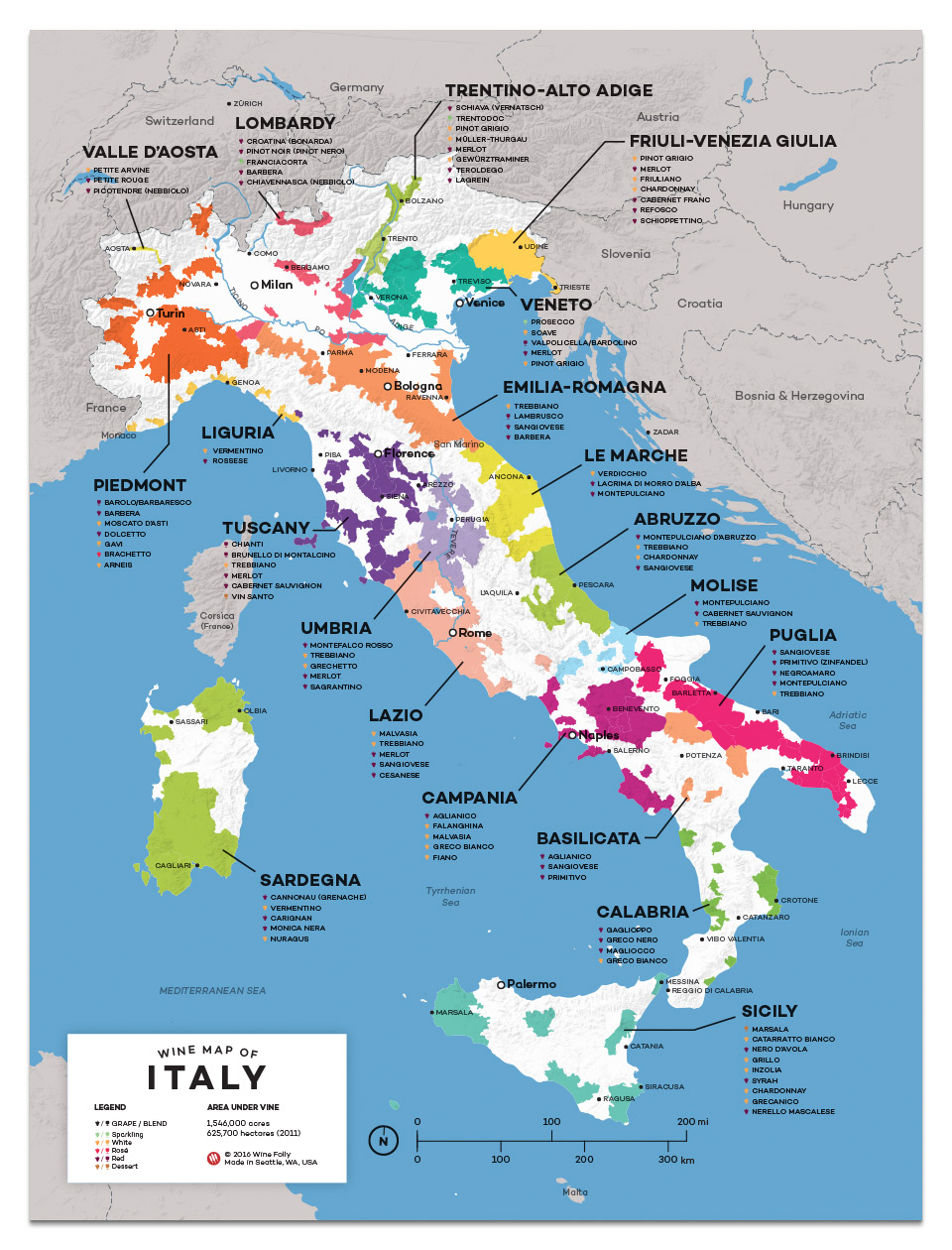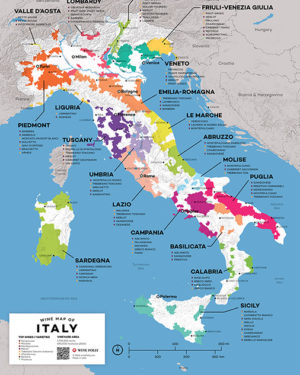Explore the map of Italian wine regions and major wine varieties. Learn about the 20 Italian wine regions and which ones to try first when delving into Italian wines.
New Guides: Discover delicious Italian wines and beautiful regions in the newly released Alto Adige Region Guide and Sicily Region Guide.
Italian wine is one of the most difficult regions to get to know. Why? Well for one, the Italians use an esoteric wine labeling system, much like the French.
But that’s not even the biggest problem in terms of familiarizing yourself with Italian wines. The hardest part is learning all the different grape varieties.
At the moment, there are about 350 official Italian wine varieties. There have been rumors that over 2,000 different Italian grapes exist, but this might be a bit of an exaggeration– something Italians do well.
Italian Wine Regions
Italy produces a huge amount of table wine, Vermouth, and cooking wines (such as Marsala). That being said, there are 3 major regions that produce high quality table wines and they are: Veneto, Tuscany, and Piedmont!
The list of Italian wine regions is organized by highest volume of DOC wines. This removes all the grapes and wines produced for making vinegar and cooking wine and low quality table wine.
A “controlled designation of origin” is a quality assurance label for Italian wine and cheese. D.O.C.G. is the highest level of this assurance label.
A “typical geographic indication” is another type of quality assurance label for Italian wine. Wines made with non-Italian grapes like Merlot and Chardonnay often fall under this category.
-
Veneto (~18% DOC production)
Keep your eyes peeled for reds and a rich white wine called Soave.
Veneto is known for the Valpolicella region which is known for producing Amarone della Valpolicella. Besides the great red blends of Valpolicella made with Corvina, Rondinella, and Molinara, there are also several fine Merlot-based IGT wines in this area. For white wines, Garganega is the white grape that makes Soave (‘swah-vay’), a wine that’s rich like Chardonnay. Check out the article below on finding wines from Veneto. -
Tuscany (~17% DOC production)
Try red wines from Tuscany as well as a sweet wine called Vin Santo.
Tuscany is home to the Chianti region which is the most famous region for Sangiovese. When Sangiovese became the required major grape in Chianti during the 1970s, the other noble grapes (Cab and Merlot) ended up creating a new style of wine: Super Tuscan.For white wines in this region, keep in mind that Trebbiano is Italy’s most produced white grape and Vermentino has quite a few taste similarities to Sauvignon Blanc.
-
Piedmont (~11% DOC production)
Try red wines and Moscato d’Asti from this area.
Nebbiolo is a grape with high tannins and pale color that has long been famous for its bristling acidity and high tannin.Besides just the great Nebbiolo wines of Barolo, the region is also home to Moscato d’Asti and the underdog varietal: Dolcetto.
Want more in-depth info? Read the essential guide on
Piedmont Wine Region with Maps -
Emilia-Romagna (~9% DOC production)
Eat the cheese from Parma and drink Lambrusco.
Lambrusco has long been thought of as a cheap, sweet, fruity wine. Now there are several outstanding off-dry to totally dry Lambruscos from Emilia-Romagna. -
Lombardy (~7% DOC production)
Check out Pinot Nero and Sparkling wines from Lombardy.
Valtellina is within Lombardy, close to Lake Como. Nebbiolo is the red wine produced here but it’s called Chiavennasca; it’s lighter and more “pinot-like” than its Piemontese sister. Lombardy also produces some great Pinot Noir (they call it Pinot Nero) especially around Oltrepò Pavese.The sparkling wine is called Franciacorta and is made with Pinot Noir, Chardonnay, and Pinot Blanc grapes in the same style as Champagne.
-
Umbria (~7% DOC production)
Look for great valued Sangiovese and Orvieto (a white wine).
Sagrantino is the red grape variety in Umbria that people go crazy over. In Montefalco, you’ll find Sagrantino, but there’s also a fair amount of strawberry-like Sangiovese in the region. The white grape here is called Grechetto, which is one of the grapes in Orvieto. It’s minerally and zesty qualities are similar to Pinot Grigio, with a distinct green almond flavor. -
Abruzzo (~7% DOC production)
Look for red wines from Abruzzo.
Montepulciano is the primary red grape in Abruzzo and the wines are called Montepulciano d’Abruzzo. This is a bit confusing because there is also a Vino Nobile di Montepulciano, which is a wine from Tuscany made with Sangiovese.Montepulciano (the grape) makes a dark, rich wine with high tannins and an herbaceous character, and is similar to Cabernet Sauvignon.
-
Trentino Alto-Adige (~6% DOC production)
Look for white wines and sparkling wines.
This region is butted up to the Alps and makes fabulous white wines from Pinot Grigio, Pinot Bianco, Gewürztraminer, and Müller-Thurgau (the latter two are sweeter). In Trento, they also produce a sparkling wine made with Pinot Noir and Chardonnay that easily rivals the best Champagne. -
Friuli-Venezia Giulia (~6% DOC production)
Look for white wines, particularly Sauvignon and Pinot Grigio.
Known for several unique and more intensely flavored styles of Pinot Grigio, (including Ramato) and Sauvignon Blanc, with a slightly meaty undertone. The area also produces some very savory and umami tasting Merlot. -
Marche (~3% DOC production)
Try refreshing and aromatic Verdicchio white wines.
Marche (Mar-kay) is known for their aromatic white wines. Verdicchio is definitely the most common, but Pecorino (the white wine grape, not the cheese) is an extremely special find. Lacrima is an up-and-coming grape from this area making fruity fun wines that reminded us of Syrah. -
Puglia (~3% DOC production)
Amazing valued reds made with Negroamaro and Primitivo.
The fruit forward red wines from Puglia (Apulia) are a great way to get started with Italian wines. Most are very affordable and the region has a great number of esoteric sweet red wines that grow nowhere else in the world. Puglia is also a known value region for Chardonnay. -
Lazio (~2% DOC production)
With Rome located in Lazio, wine production is relatively small. Still, refreshing and zesty Grechetto can be found here, along with Malvasia, an aromatic rich and sweet wine.
-
Sicily (~1% DOC production)
Try a red wine called Nero d’Avola.
Red wines from Sicily are dark, rich, and fruit forward because of the warm climate. Nero d’Avola is an awesome red variety that’s worthy of nobility. -
Sardinia (~1% DOC production)
You gotta try Cannonau and Vermentino.
At some point ampelographers discovered that Sardegna’s pride, Cannonau, is actually Grenache. In Sardegna (Sardinia), it tastes more rustic with dried fruit flavors. The wines from Sardegna (Sardinia) are highly aromatic and usually offered at a great value. -
Campania (~0.5% DOC production)
Aglianico is a very high tannin and rustic red wine. Traditionally, it takes about 10 years of aging to be drinkable. Recently Aglianico wines have gained momentum as producers have figured out how to dial back Aglianico’s rugged meaty tannins.
That said, there’s nothing more guttural than a 10 year-old traditional Taurasi. Also check out Greco, a refreshing white wine with a bitter almond finish.
-
Liguria (~0.2% DOC production)
A very beautiful region that was not famous for their wines. Fortunately, some delicious white wine blends have surfaced with a tingle of salinity from the sea air.
Perfect seafood wine. There is also a crazy producer of sparkling wines that ages them in the bottom of the sea.
-
Calabria (~0.17% DOC production)
Greco is the white wine of choice in this region.
-
Molise (~0.1% DOC production)
Molise produces some interesting red wines.
-
Basilicata (~0.1% DOC production)
Awesome and intimidating Aglianico that is grown on the side of a Volcano.
-
Valle d’Aosta (~0.05% DOC production)
The smallest wine region in Italy, in the alps, producing some Pinot Noir rosé and two regional grapes: Petit Rouge (a red) and Petite Arvine (a white).
Explore Italian wine
Get the wine map of Italy and taste your way through all 20 unique regions!


